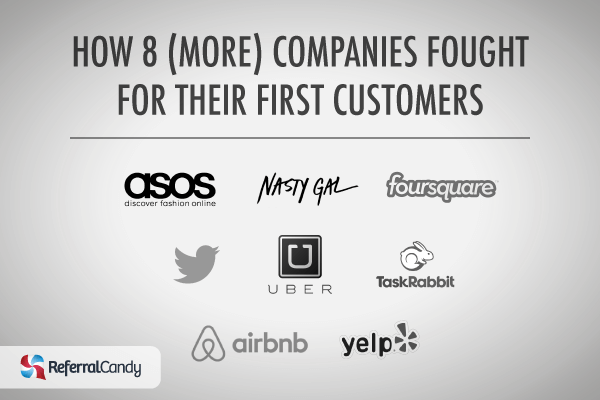The Strategic Tactics Used by 22 Companies to Secure Their First Customers

Some businesses are better suited for the freemium model than others. For Evernote, offering a free version of their product allowed them to acquire customers cheaply and efficiently, as users could start using the service without any financial commitment. This strategy worked well for Evernote because the more customers used the service, the more they saw the value in it and were willing to pay for additional features.
On the other hand, Yammer took a different approach to customer acquisition by using their product as its own marketing tool. Yammer, a social networking platform for businesses, focused on creating a product that was so valuable and integral to a company’s workflow that users would naturally spread the word to their colleagues and peers. This word-of-mouth marketing strategy helped Yammer gain traction within organizations and grow their user base organically.
Both Evernote and Yammer demonstrate the power of innovative customer acquisition strategies. By leveraging the freemium model and creating a product that markets itself, these companies were able to acquire customers, build a loyal user base, and achieve success in their respective industries.
In conclusion, acquiring customers is a crucial aspect of building a successful business. While it may seem like successful companies have always had a large customer base, the reality is that even the biggest companies had to start from scratch at one point. By implementing creative and strategic customer acquisition tactics, businesses can attract new customers, retain existing ones, and ultimately grow their brand and revenue. The success stories of companies like Evernote, Yammer, OKCupid, Etsy, Buffer, ASOS, Nasty Gal, Twitter, and Foursquare serve as a testament to the power of innovative marketing strategies in driving customer loyalty and growth. These companies have not only managed to attract a large customer base but have also retained their customers by offering valuable services and products over time. By implementing unique and creative marketing tactics, these companies have been able to stand out in their respective industries and build a strong brand presence.
One key factor that stands out in the success stories of these companies is their ability to leverage the power of word-of-mouth marketing. Evernote’s referral program, for example, has been instrumental in gaining millions of users through word-of-mouth. By encouraging existing users to refer their friends and colleagues to the platform, Evernote has been able to exponentially grow its user base while driving down customer acquisition costs.
Yammer, on the other hand, baited customers with a free basic version of its platform, which led to a 15% conversion rate to the premium option. By offering a freemium model, Yammer was able to attract a large number of customers and convert them into paying users over time. This strategy not only helped Yammer acquire new customers but also retain them by providing a valuable service that met their needs.
OKCupid’s legendary content on OKTrends was another example of a successful marketing strategy that drove customer engagement and loyalty. By sharing insightful and compelling content on topics like sex and relationships, OKCupid was able to attract a large audience and generate thousands of shares and likes on social media. This content-driven approach not only helped OKCupid build brand awareness but also positioned the company as a thought leader in its industry.
Etsy’s strategy of reaching out to target communities before launching its marketplace for handmade crafts was another key factor in its success. By engaging with the craft community on platforms like getcrafty.com and Craftster.org, Etsy was able to generate interest and build a strong foundation for its platform before launch. This early engagement with potential customers helped Etsy kickstart its business and attract sellers and buyers to its platform.
Buffer’s growth to 100k users was primarily driven by frequent guest blogging, with co-founder Leo Wildrich writing 150 guest posts in the first 9 months of running the company. By leveraging guest blogging as a marketing strategy, Buffer was able to reach a wider audience and build relationships with other industry experts. This not only helped Buffer acquire new users but also establish itself as a trusted source of information in the social media space.
ASOS’s decision to mail its own print magazine to 400,000 customers was another innovative marketing strategy that helped the company build a loyal fanbase. By combining a content-rich website with a glossy print catalog, ASOS was able to engage customers on multiple channels and create a seamless shopping experience. This multi-channel marketing approach, combined with a generous shipping and returns policy, has helped ASOS become a global ecommerce powerhouse.
Nasty Gal’s success story is a testament to the power of listening and tweaking in marketing. Founder Sophia Amoruso’s hands-on approach to product display and customer feedback allowed the company to experiment and iterate until they found the right formula for success. By continuously listening to customer feedback and making adjustments to their product offerings, Nasty Gal was able to build a strong brand and attract a loyal customer base.
Twitter and Foursquare’s explosive growth at SXSW through guerrilla marketing tactics further demonstrate the importance of creativity and innovation in marketing. By live streaming the conference on plasma screens and creating event-specific features, these companies were able to generate buzz and attract new users in a short period of time. This guerrilla marketing approach not only helped Twitter and Foursquare gain traction but also solidified their presence in the market.
In conclusion, the success stories of these companies highlight the importance of implementing unique and creative marketing strategies to drive customer loyalty and growth. By leveraging the power of word-of-mouth marketing, content-driven campaigns, community engagement, guest blogging, multi-channel marketing, customer feedback, and guerrilla tactics, these companies have been able to differentiate themselves in a crowded marketplace and build strong brand identities. As businesses continue to evolve and adapt to changing consumer preferences, these success stories serve as a valuable guide for companies looking to stand out and succeed in today’s competitive landscape. Panelists and speakers mentioned the service, and the bloggers in attendance touted it. During the event, Twitter usage went from 20,000 tweets per day to 60,000. This surge in social media activity highlighted the impact of effective marketing strategies on audience engagement.
One notable success story from the event was Foursquare, which managed to grow its average check-ins from 250k to 350k with just chalk and rubber balls. Foursquare’s unconventional approach of setting up a game of four square in front of the convention hall without a booth or a large marketing budget paid off. Thousands of walk-up participants were drawn to the game, and CEO Dennis Crowley noted that they were able to engage with attendees and help them understand and use the Foursquare app.
Another standout example is Uber, which responded quickly to transportation gaps during a bus worker strike in Boston by offering free rides to stranded Boston Public School students. This act of kindness not only garnered massive publicity but also helped Uber establish a positive reputation within the local community. Additionally, Uber’s partnership with Cheezburger for the UberKITTENS campaign, where kittens were delivered to callers for 15-minute petting sessions, was a viral success that raised funds for animal shelters.
Taskrabbit, a service similar to Uber, focused on delighting moms in Boston to gain early traction. By targeting a specific customer segment, Taskrabbit was able to corner the market and leverage word-of-mouth marketing to expand its user base. Airbnb, on the other hand, went the extra mile to talk to their first users by shuttling from coast to coast to acquire and engage with them personally. This hands-on approach helped Airbnb generate buzz and excitement, leading to rapid growth and expansion.
Yelp, known for its user-generated reviews, incentivized quality reviews by rewarding users with “Kudos” for good behavior. By creating a tight community of consistent reviewers, Yelp was able to maintain a loyal user base and encourage high-quality contributions.
Overall, these examples demonstrate the power of creative marketing strategies and customer engagement in driving growth and success for businesses. By focusing on building relationships, providing value, and creating memorable experiences, companies can effectively connect with their target audience and achieve long-term success.
The Power of Reward Mechanisms in Driving User Engagement: A Case Study of Yelp
Yelp, a popular review platform, has been successful in driving user engagement by implementing special recognition for users who are the first to review a business. Additionally, they allow other users to give kudos for reviews that are deemed useful, funny, or cool. This strategy has proven to be highly effective, as evidenced by the numbers in 2006 which show that a significant percentage of Yelp reviewers became hooked on the site.
According to data from 2006, a whopping 65.8% of users who contributed 6 or more reviews were on Yelp, compared to only 4.8% on CitySearch and 11.1% on Yahoo Local. Furthermore, only 9.2% of users who left only one review were on Yelp, while the majority were on CitySearch (71.2%) and Yahoo Local (56.4%). This data highlights the strong user engagement on Yelp, indicating that the platform has been successful in retaining users and encouraging them to contribute multiple reviews.
Treating Elite Users Generously
One key strategy that Yelp has employed to drive user engagement is treating their best users, known as “Elite” users, generously. These Elite users are distinguished by a shiny badge on their account profile, and they contribute significantly to the site’s content. In fact, by 2006, a remarkable 44% of reviews on Yelp were contributed by Elite users.
Dave Kim, a six-year Yelp Elite user with over 900 reviews, explains the effectiveness of Yelp’s reward mechanisms in driving user engagement. He mentions that Yelp rewards users not through monetary means, but through perks such as early access to events, free food and drinks, and exclusive swag. These incentives motivate Elite users to continue contributing to the platform, thereby enhancing user engagement and content quality.
Groove: Reaching Out to Customers That “Got Away”
Another successful example of driving user engagement is Groove, a customer service platform that reached out to customers who initially chose their competitors. By sincerely asking these customers for feedback on their choice, Groove was able to identify and fix bugs, as well as convince customers to give them another chance. This strategy of reaching out to lost customers and addressing their concerns has proven to be highly effective in driving user engagement and retention.
Recap: Early Traction Tips from Successful Companies
- Physically travel to your target user base [Tinder, Alibaba]
- Populate your site with your own content to get other users on board [Quora, Reddit]
- Design your campaign to encourage word-of-mouth [Dropbox, Threadless]
- Use Facebook as a product feedback loop and marketing tool [Lolly Wolly Doodle]
- Delight fandoms to yield high returns [Black Milk]
These tips, along with the examples of Yelp and Groove, highlight the importance of implementing reward mechanisms and reaching out to lost customers in driving user engagement. By focusing on user satisfaction and providing incentives for active participation, companies can effectively increase user engagement and retention.
FAQs
1. How does Yelp reward its Elite users?
Yelp rewards its Elite users with perks such as early access to events, free food and drinks, and exclusive swag. These incentives motivate Elite users to continue contributing to the platform.
2. What was Groove’s strategy for driving user engagement?
Groove reached out to customers who initially chose their competitors and asked for feedback on their choice. This strategy helped Groove identify and fix bugs, as well as convince customers to give them another chance.
3. Why is user engagement important for business success?
User engagement is important for business success because it increases customer loyalty, drives repeat purchases, and enhances brand reputation. Engaged users are more likely to recommend the business to others, leading to organic growth and increased revenue.
4. How can companies incentivize user engagement?
Companies can incentivize user engagement by offering rewards, exclusive perks, and recognition to active users. By creating a sense of community and providing value to users, companies can encourage continued participation and loyalty.
5. What are some other examples of successful user engagement strategies?
Some other examples of successful user engagement strategies include personalized recommendations, gamification, interactive content, and responsive customer support. These strategies help create a positive user experience and foster long-term relationships with customers.
the topic of climate change and its impact on global food security.
Climate change is one of the most pressing issues facing the world today, with far-reaching implications for everything from weather patterns to sea levels. One of the most concerning impacts of climate change is its effect on global food security. As temperatures rise and extreme weather events become more frequent, the world’s ability to produce enough food to feed a growing population is being put at risk.
One of the key ways in which climate change is impacting food security is through changes in agricultural productivity. Rising temperatures and changing precipitation patterns can lead to reduced crop yields and decreased livestock productivity. This can have serious consequences for food availability, particularly in regions that are already experiencing food insecurity. In addition, extreme weather events such as droughts, floods, and storms can destroy crops and infrastructure, further jeopardizing food production.
Another major impact of climate change on food security is its effect on food prices. As crop yields decrease and food production becomes more volatile, prices are likely to rise, making food less affordable for the world’s most vulnerable populations. This can lead to increased hunger and malnutrition, as well as political instability and conflict in regions that are already struggling to feed their populations.
Climate change also has implications for food distribution and access. As extreme weather events become more common, transportation and infrastructure networks are at risk of being disrupted, making it difficult for food to reach those who need it most. This can exacerbate food insecurity in already vulnerable communities and regions, leading to increased food shortages and malnutrition.
In order to address the impact of climate change on global food security, it is crucial that we take urgent action to reduce greenhouse gas emissions and mitigate the effects of climate change. This includes investing in sustainable agricultural practices, such as crop diversification and soil conservation, as well as improving food distribution systems to ensure that food reaches those who need it most. It also requires building resilience in food systems to cope with the effects of climate change, such as developing drought-resistant crops and improving water management practices.
Ultimately, addressing the impact of climate change on global food security requires a coordinated and holistic approach that takes into account the complex interactions between climate, agriculture, and food distribution. By taking action now to mitigate the effects of climate change, we can help ensure that future generations have access to a secure and sustainable food supply. the topic of “The Benefits of Volunteering.”
Volunteering is a selfless act that involves giving your time and skills to help others in need without expecting anything in return. It is a powerful way to make a positive impact on your community and the world at large. While the primary goal of volunteering is to help others, there are also numerous benefits that volunteers can experience themselves.
One of the most significant benefits of volunteering is the sense of fulfillment and satisfaction that comes from helping others. Knowing that you have made a difference in someone’s life, no matter how small, can be incredibly rewarding. This feeling of accomplishment can boost your self-esteem and overall sense of well-being.
Volunteering also allows you to connect with others and build meaningful relationships. Whether you are working alongside other volunteers or interacting with those you are helping, volunteering provides opportunities to meet new people and form bonds based on a shared goal of making the world a better place. These connections can lead to lasting friendships and a sense of belonging within your community.
In addition to the emotional benefits, volunteering can also have a positive impact on your physical health. Studies have shown that volunteering can reduce stress, improve mental health, and even lower the risk of developing chronic diseases such as heart disease. By focusing on helping others, volunteers often experience a sense of purpose and fulfillment that can improve their overall well-being.
Volunteering can also provide valuable skills and experiences that can enhance your personal and professional development. Whether you are learning new skills through hands-on volunteer work or gaining leadership experience by organizing volunteer events, volunteering can help you build a strong resume and stand out to potential employers. Additionally, volunteering can provide opportunities to explore new interests and passions, leading to personal growth and self-discovery.
Furthermore, volunteering can have a positive impact on society as a whole. By giving back to your community and helping those in need, you are contributing to the greater good and creating a more compassionate and caring world. Volunteering can inspire others to get involved and make a difference, creating a ripple effect of kindness and generosity that can benefit countless individuals and communities.
In conclusion, the benefits of volunteering are vast and far-reaching. From personal fulfillment and well-being to building relationships and gaining valuable skills, volunteering offers a wealth of rewards for both the volunteer and the community they serve. By dedicating your time and energy to helping others, you can make a positive impact on the world and experience the joy of giving back. So why not take the first step and start volunteering today? The world could certainly use more kindness and compassion, and you have the power to make a difference.



